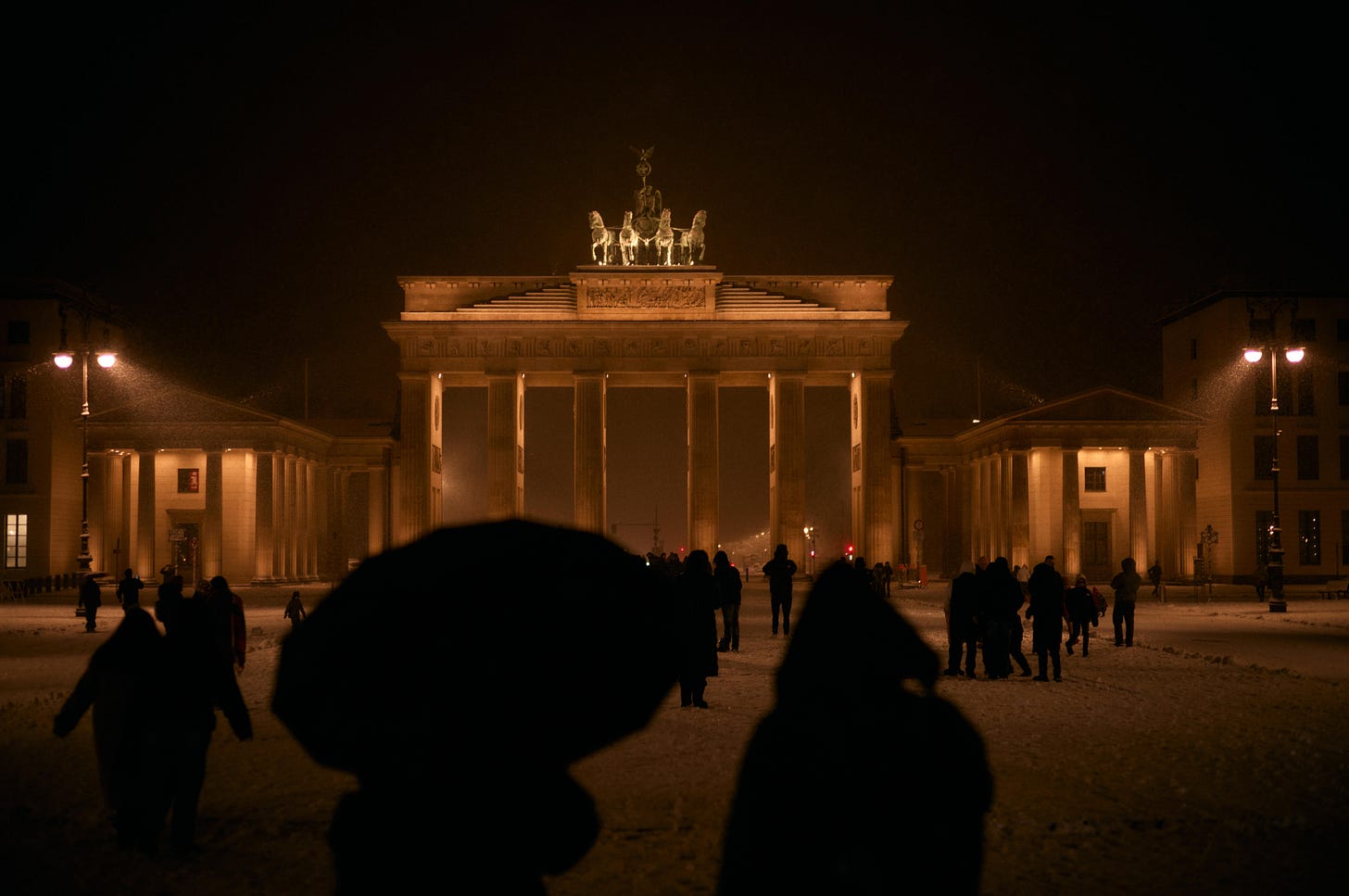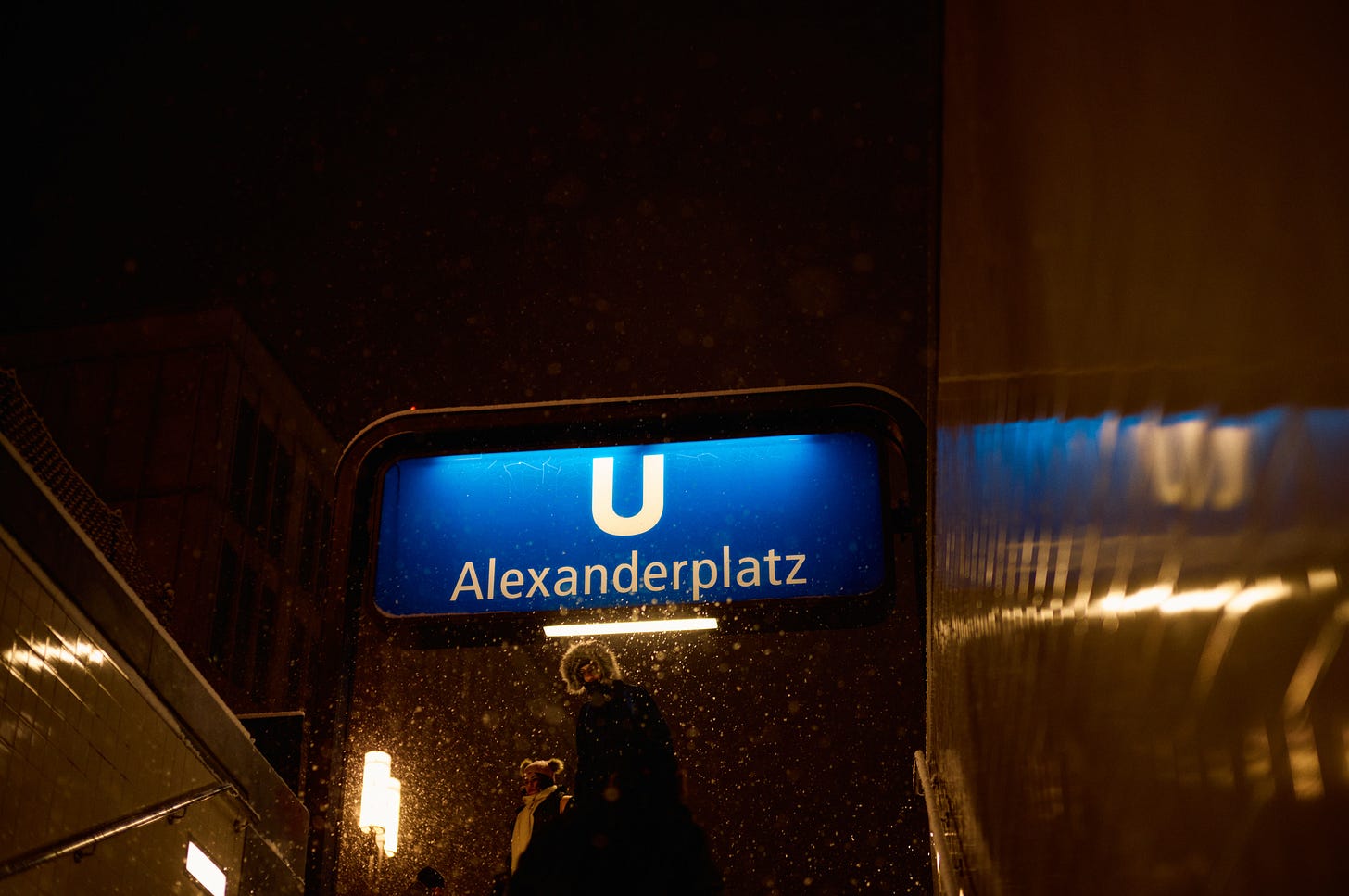Berlin Wasn’t Meant to Be This Way, That’s Why It Works
Thanks to my grandfather’s meticulous research, I know more about my 18th-century Prussian ancestors than I do about my own tax filings.
This wasn't supposed to be the Substack post I would write this week. I'd hoped to head out to Eisenhüttenstadt, a planned city built in the Stalinist neoclassical style on the border with Poland in the 1950s. But the trains froze, the snow fell, and Berlin pulled me back. So instead, I spent the day trudging through snow, camera in hand, wandering Berlin's streets without a fixed route in mind. And instead, you'll get a short yet meandering train of thought to accompany this photo essay.
Wandering through Lichtenberg, Mitte, Kreuzberg, and Prenzlauer Berg, I kept thinking about what this city really is. Other European capitals curate their past like a well-lit museum exhibit. But Berlin doesn't curate history. It weaponises it. Berlin is the man on the U8 ranting about lizard people. It's the bullet holes still marking building facades, the brass Stolpersteine name the Jewish residents deported to concentration camps, and the half of the city that is still a socialist urban planning experiment.
Berlin is modern history's ultimate accidental city. A metropolis at the centre of the 20th century's defining moments often feels like a place that shouldn't exist, or at least not in the form it does. In its current form, the city feels like a software glitch. Founded on a swamp (its Wendish name? "Berl," meaning mud), it rose as Prussia's stern-faced capital, mutated into Weimar's den of debauchery, and survived Hitler's spite (he loathed its "degenerate" cool). Berlin then became the ultimate ideological A/B test experiment. Socialism on one side, capitalism on the other, and a four-metre wall splitting the city in half. In other words, it's a city that's constantly rewriting itself.
But here's a secret I sometimes need to remind myself of: a small part of Berlin's chaos is coded into my DNA.
In 1747, my great-great-great-great-grandfather, Christian Gottlieb Starcke, was born here. His father tailored coats for Prussian nobles; his mother's side of the family counted taxes in Brandenburg. Christian, a restless opportunist, fled to Russia, and became Catherine the Great's personal tailor (let's pretend it was the 18th-century equivalent of moving to Bali to "find yourself"). Later, he jumped ship (literally) to England, stitching uniforms for the Royal Navy during the American Revolution. Eventually, he settled in London, married the daughter of German immigrants, and opened a Savile Row-esque boutique, only to die near Leicester Square in 1808, far from the Prussian dourness that birthed him.
Fast-forward 250 years. I'm here, trudging past Alexanderplatz's Brutalist Fernsehturm (TV tower), slushy snow becoming wet socks, to take moody photos in a blizzard. My ancestor fled Berlin for adventure; and I came back to fart around, take pictures and write about it all in a silly Substack. History's a carousel: maybe my descendants will likely flee this Berlin too, chasing cheap rent, maybe to Reykjavík or Montreal. Unless, of course, the city swallows them first.
Berlin doesn't let you romanticise. Scruffy facades, Soviet gargoyles, and anarchist graffiti are all part of the city's grubby syntax. But that's its charm. Like my tailor ancestor, it reinvents relentlessly, stitching new skins over old wounds.
Footnote: I know all of this geneology because my late grandfather was a meticulous historian of our family’s past. He spent years researching and documenting the lives of our ancestors on my maternal side, leaving behind an extensive written account of our family history. Without his work, Christian Gottlieb Starcke’s journey from Berlin to Russia to England would have been lost to time, or at least reduced to a vague family myth.
You’ve made it to the end
Thank you for reading. If you’re enjoying reading my silly stories, please recommend my Substack to a friend or drop a comment. I have some more Germany stories coming up soon, stay tuned! Follow me on Instagram or Bluesky (if you’ve had enough of our tech overloards).














Wish i'd been able to spend time wandering Berlin with you Ari dear. Great writing and images.
Wow that is an incredible family history, it must have been amazing to read your late grandfathers notes. Beautiful colour in these Ari - I'm loving the tram image!